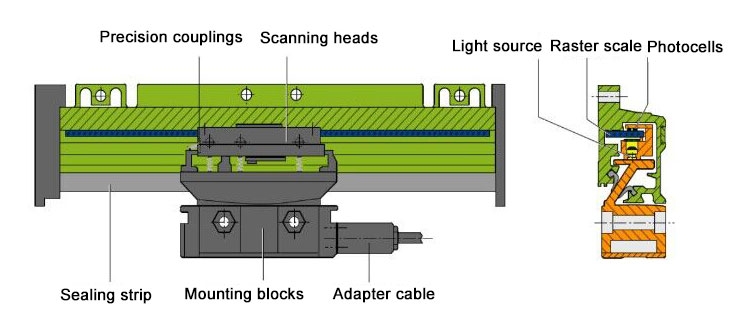A scale, also known as a scale displacement sensor (scale transducer), is a measurement and feedback device that works with the optical principle of a grating. Often used in closed-loop servo systems for CNC machine tools, optical scales can be used to detect linear or angular displacements. Linear scale is one of the types of scale, an optical sensor device used to measure linear displacement, the main principle of which is based on the interference and diffraction effects of light. It is widely used in industrial automation, CNC machine tools, precision measurement, etc. sisco shop will introduce the structure, basic principle, and application of linear scale in detail.
Main Parts
- Base: The base of the linear scale is the foundation of its support and installation, usually made of high hardness and high stability materials to ensure the stability and accuracy of measurement.
- Reference Scale: The reference scale of linear scale is a fine grating bar with a series of evenly distributed grating lines engraved on it. These lines are usually manufactured using laser etching technology to ensure accuracy and stability.
- Readhead: The readhead is the component mounted on the object under test that reads the lines on the linear scale. Typically, the read-head contains a photoreceptor and associated circuitry that converts the positional information of the scale lines into electrical signals.
- Cables and Interfaces: Cables are used to connect the readhead of the linear scale to the associated electronics and to transmit the measurement signals. Interfaces are usually designed as standard digital interfaces for easy connection to a variety of digital displays and control systems.
- Protective Cover: Because of the various contaminants and mechanical risks that may be present in the operating environment of a linear scale, a protective cover is usually provided to protect the reference scale and read-head of the linear scale and to ensure that it operates stably for a long period.
- Signal Processing Unit: The signal processing unit is used to receive signals from the read-head and process them to convert the position information into a readable digital or analog output. This usually includes electronic components such as decoders, filters, and amplifiers.
- Display Unit: The measurement results of the linear scale can be displayed through a digital display unit, making it easy for the user to intuitively access the measured values.

Linear Scale Features
- High-precision Measurement: linear scale adopts optical principle, through the photoelectric converter will grating on the engraved line signal into an electrical signal, realize high-precision position measurement, usually can reach the sub-micron level of measurement accuracy.
- High Resolution: Linear scales have a very small scale pitch and therefore a high resolution. This makes linear scale the need for small-scale measurement and motion control in the field of widely used, such as CNC machine tools, and semiconductor manufacturing.
- Strong Stability: the structure design of linear scale usually takes into account the influence of temperature change and mechanical vibration on the measurement, and adopts the anti-interference design, which makes it possible to maintain stable measurement performance under different environmental conditions.
- Fast Response: photoelectric sensors can quickly convert the signal on the grating, thus realizing fast position feedback, suitable for application scenarios requiring high-speed movement and real-time control.
- Strong Abrasion Resistance: Linear encoder is usually made of abrasion-resistant material, which has strong abrasion resistance and can maintain good performance in long-term use.
Basic Principle
The main components of the scale include a light source, grating bar, and photodetector. The light source emits light which, after passing through the grating bars, produces a series of equidistant light rays, forming a light diffraction effect. These rays are projected onto the photodetector. When the object moves, the scale is fixed, but due to the displacement of the object, the light rays on the scale undergo phase changes on the photodetector. The photodetector converts these changes into electrical signals, which are processed to obtain the corresponding displacement information. By measuring the phase change on the linear scale, the displacement of the object can be accurately determined.
Application Areas
- CNC Machine Tools: Linear scales are used in CNC machine tools to measure the position of tools and workpieces to ensure accurate cutting and machining.
- Printing and Paper Industry: Linear scales are used in printing machines and paper-cutting machines to ensure accuracy and consistency in printing or cutting.
- Laser Cutting Machines: Linear scales are used in laser cutting machines to provide accurate monitoring of the position of the table and cutting head for high-precision cutting.
- Medical Equipment: In medical imaging equipment, a linear scale is used to measure the position of moving parts in devices such as CT scanners and MRI machines to ensure image accuracy and clarity.
- Semiconductor Manufacturing: In semiconductor production, linear scale is used to measure and control the position and size of cutting, etching, and other processing to ensure the accuracy and quality of the chip.
- Precision Measuring Instruments: Linear scales are widely used in a variety of precision measuring instruments, such as coordinate measuring machines, optical measuring instruments, etc., to provide high-precision measurement results.
- Robotics and Automation Systems: In industrial robotics and automation systems, a linear scale is used to measure the position of robot end-effectors to ensure accurate positioning and operation.
- Aerospace: Linear scales are used in aircraft and satellites for navigation, position control, and precision measurement to ensure the reliability and accuracy of aerospace equipment.

As a high-precision optical measuring device, linear scale realizes the accurate measurement of linear displacement through the principle of light interference and diffraction. Its wide application in industrial automation, CNC machine tools, precision measurement, and other fields provides reliable displacement measurement solutions for manufacturing and scientific research. With the continuous progress of technology, the linear scale will show more potential and application prospects in more fields.

